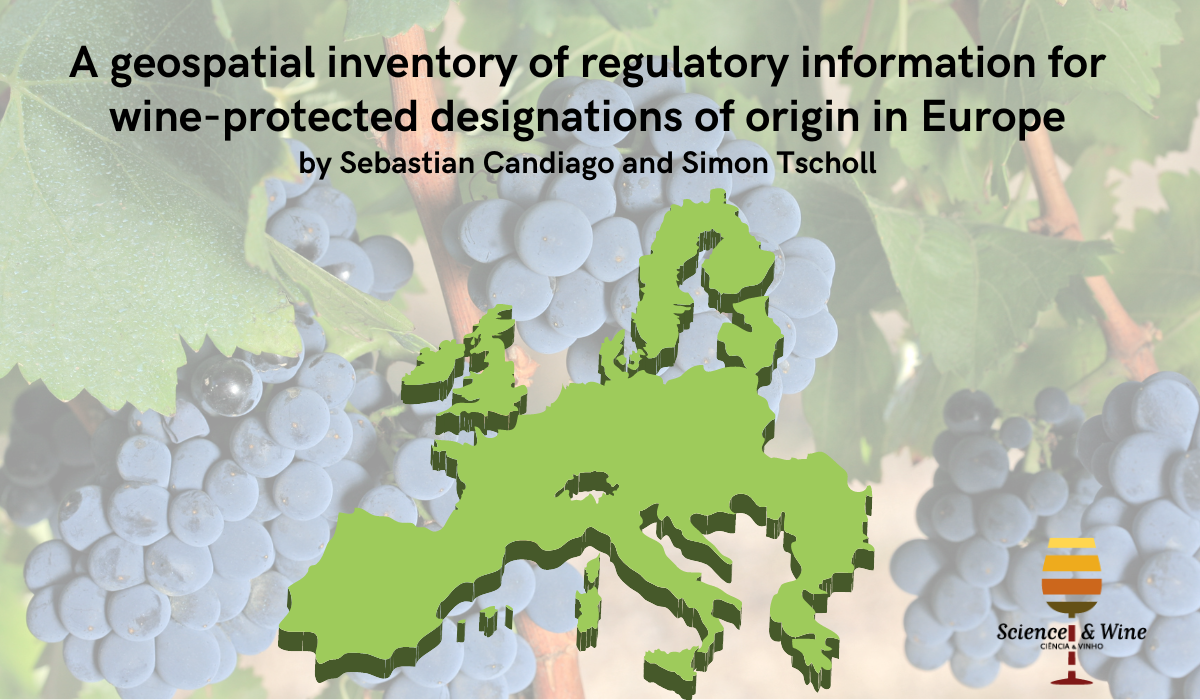By Sebastian Candiago, Simon Tscholl, Leonardo Bassani, Helder Fraga and Lukas Egarter Vigl
The Protected Designation of Origin (PDO) label is a European Union (EU) quality scheme that protects products made in specific areas, under distinctive physical and biological conditions and using strictly defined production practices1. It therefore includes strict regulations regarding cultivation and production processes together with the definition of the area where the grapes must be cultivated. These regulations are included in a set of documents e.g., product specifications that are reviewed and accepted by the European Commission.

Figure 1: wine PDO areas included in the inventory, based on the municipality boundaries from Eurogeographic (© EuroGeographics 2022).
Due to the strong relation between PDO wines and the specific conditions and production practices defined in the regulation documents, these products are highly vulnerable to any changes in the climatic, environmental, or economic conditions in the production area. For example, warmer conditions may change the growing suitability of traditional cultivars or favour the introduction of alien pest species2–3. All these factors are often in conflict with the specifications defined in the regulatory documents. To maintain their quality standards, PDO areas therefore may need to use different production practices than those authorized in the regulatory documents and there is a need to thoroughly plan and develop specific adaptation strategies that consider the local conditions and legal specifications of individual PDO regions. Such strategies require knowledge about the legal specifications that characterize each PDO, which is currently only available in the regulatory documents of each wine PDO and not as a harmonized dataset.

To fill this knowledge gap, we collected, harmonized, and spatialized a set of regulatory information using the legal documents included in the EU geographical indication register eAmbrosia4 for all of the 1177 wine PDO areas in the EU (as of 04.11.2021). The regulatory specifications were spatialized using the boundaries of the municipalities included in each PDO (Figure 1). We included a set of regulatory information, such as authorized varieties, planting density, maximum yield or possibility for irrigation (Figure 2). This dataset will be particularly useful because of its potential applications for researchers and decision makers in the field of viticulture. For example, the knowledge of regulatory information, such as the planting density, yield, and vine variety, can be used by researchers to calibrate crop models and generate projections of phenology and water stress indicators in PDO areas2. The results of these models can support the development of adaptation solutions for climate change such as the inclusion of new vine cultivars or the authorization of irrigation in a PDO5. The analysis of PDO documents’ contents can also improve our understanding of the critical factors that determine the sustainability and reputation of PDO regions, as it was shown in recent studies. For example, Marescotti et al.6, studied the amendments of protected geographical indications in the fruit and vegetable sector finding that there is the need to introduce more environmental criteria in the regulatory documents, and Scozzafava et al.7, analysed how a change in PDO regulations can promote the premium products from a wine PDO region.
Reference to the data descriptor paper: Candiago, S., Tscholl, S., Bassani, L., Fraga, H., & Egarter Vigl, L. A geospatial inventory of regulatory information for wine Protected Designations of Origin in Europe. Scientific Data, 9 (394). https://doi.org/10.1038/s41597-022-01513-0 (2022).
Reference to the downloadable dataset: Candiago, S., Tscholl, S., Bassani, L., Fraga, H., Egarter Vigl, L. A geospatial inventory of regulatory information for wine protected designations of origin in Europe. figshare https://doi.org/10.6084/m9.figshare.c.5877659.v1 (2022).
On behalf of all authors:

Sebastian Candiago
Is a PhD student in Science and Management of Climate Change at the Ca’ Foscari University of Venice and Eurac Research. He studies the impact of climate change on viticultural systems using an interdisciplinary approach, combining tools and methods from different fields, e.g., geography and ecology, to analyze the status and future evolution of European winegrowing regions.

Simon Tscholl
Is a PhD student in Biology at the Leopold-Franzens-Universität of Innsbruck and Eurac Research. He studies the relations between climate change and viticultural systems with a focus on mountain areas. In particular, he focuses on growing suitability and adaptation strategies, using climatic and phenological models and geographic information system techniques.
References
- Clark, L. F. & Kerr, W. A. Climate change and terroir: The challenge of adapting geographical indications. J. World Intellect. Prop. 20, 88–102 (2017).
- Fraga, H., Atauri, I. G., de, C., Malheiro, A. C. & Santos, J. A. Modelling climate change impacts on viticultural yield, phenology and stress conditions in Europe. Global Change Biol. 22, 3774–3788 (2016).
- Caffarra, A., Rinaldi, M., Eccel, E., Rossi, V., & Pertot, I. (2012). Modelling the impact of climate change on the interaction between grapevine and its pests and pathogens: European grapevine moth and powdery mildew. Agriculture, Ecosystems & Environment, 148, 89–101.
- European Commission – Food, Farming, Fisheries. eAmbrosia, the EU geographical indication register https://ec.europa.eu/info/food-farming-fisheries/food-safety-and-quality/certification/quality-labels/geographical-indications-register/ (2022).
- Santos, J. A. et al. A Review of the Potential Climate Change Impacts and Adaptation Options for European Viticulture. Appl. Sci. 10, 3092 (2020).
- Marescotti, A. et al. Are Protected Geographical Indications Evolving Due to Environmentally Related Justifications? An Analysis of Amendments in the Fruit and Vegetable Sector in the European Union. Sustainability 12, 3571 (2020).
- Scozzafava, G., Gerini, F., Dominici, A., Contini, C. & Casini, C. Reach for the stars: The impact on consumer preferences of introducing a new top-tier typology into a PDO wine. Wine Econ. Policy 7, 140–152 (2018).

